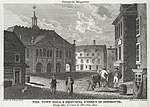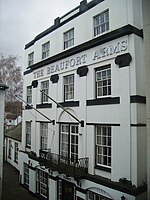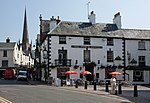Nelson Garden
Buildings and structures in Monmouth, WalesGardens in WalesGrade II* listed buildings in MonmouthshireMonmouth, WalesMonuments and memorials to Horatio Nelson ... and 2 more
Registered historic parks and gardens in MonmouthshireTourist attractions in Monmouthshire

The Nelson Garden, on 13 Chippenhamgate Street, at the rear of No.18 Monnow Street, Monmouth, Monmouthshire is a 19th-century garden that was the scene of a tea party held to honour Lord Nelson in 1802. The garden is one of 24 sites on the Monmouth Heritage Trail. It is bounded on the south by the line of the medieval town wall through which it is entered via a short underground passageway. The garden has limited public access and is now managed by a trust. It is included on the Cadw/ICOMOS Register of Parks and Gardens of Special Historic Interest in Wales.
Excerpt from the Wikipedia article Nelson Garden (License: CC BY-SA 3.0, Authors, Images).Nelson Garden
St John's Street,
Geographical coordinates (GPS) Address Nearby Places Show on map
Geographical coordinates (GPS)
| Latitude | Longitude |
|---|---|
| N 51.811 ° | E -2.7156 ° |
Address
St John's Street
St John's Street
NP25 3EA , Overmonnow
Wales, United Kingdom
Open on Google Maps










